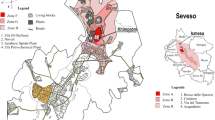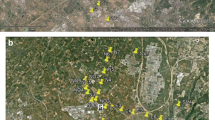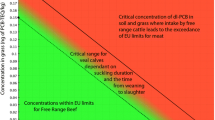Abstract
α-HCH, β-HCH, and γ-HCH (lindane) were listed as persistent organic pollutants in the Stockholm Convention. Therefore, they need to be globally addressed including the wastes remaining from historic use and production. While at most lindane production sites the unintentionally produced 85 % HCH waste isomers have been deposited, at a former pesticide factory in Hamburg-Moorfleet HCH waste isomers have been recycled from 1953 to 1984 by thermal decomposition to chlorobenzenes and resulted in high polychlorinated dibenzo-p-dioxin/polychlorinated dibenzofuran (PCDD/PCDF)-contaminated residues. The management of the PCDD/PCDF-contaminated waste from the former pesticide factory in Hamburg has been assessed and quantified. Based on past accredited PCDD/PCDF measurements, the registered 3,700 tonnes of disposed thermal HCH decomposition residue contained 333 to 854 kg of PCDD/PCDF toxicity equivalent (I-TEQ) in 53–102 tonnes total sum of PCDD/PCDF. The wastes have been deposited together with other wastes in landfills in Hamburg and other parts of Germany. For the Georgswerder landfill (Hamburg), where approximately 50 % of the PCDD/PCDF is disposed, current and previous situation and remediation activities are described. While PCDD/PCDF leaching from the landfill is controlled and incinerated, more water soluble organochlorines (vinyl chloride, cis-1,2-dichlorethene, chlorobenzenes) and benzene remain as a challenge for groundwater management. A comprehensive aftercare program has been established and will need to be operated by future generations including renewal of containment systems. Former lindane/HCH productions need—in addition to HCH deposits—to be assessed for possible recycling practice of HCH and related PCDD/PCDF-containing deposits. This could systematically be addressed within the Stockholm Convention implementation.






Similar content being viewed by others
Notes
In 2010, a symposium on 25 years of remediation of the Georgswerder landfill has been held. Some key findings are summarized in this paper: http://www.hamburg.de/energieberg-georgswerder/2344370/25-jahre-deponie-georgswerder-fachtagung.html
Germany submitted PCDD/PCDF releases to air (for 2004).
See footnote 1.
References
Bodenstein G (1972) Disposal of wastes from lindane manufacture. In: Uhlmann E, Verlag K (eds) Lindane monograph of an insecticide. Schillinger, Freiburg im Breisgau, pp 23–77
Bürgerschaft Hamburg. (1985): Bürgerschaft der Freien und Hansestadt Hamburg, 11. Wahlperiode. Drucksache 11/3774, 26.02.1985
Degler H-D, Uentzelmann D (Ed.) (1984) In supergift dioxin. Spiegel Buch, Rudolf Augstein GmbH Co. KG Hamburg, Germany
Fiedler H, Hub M, Hutzinger O (1993) Stoffbericht Hexachlorcyclohexan (HCH); HCH in Altlasten Text und Berichte zur Altlastenbearbeitung , Band 9/93, Landesanstalt für Umweltschutz Baden-Württemberg
Gillbricht C, Effenberger M, Sokollek V (2012) Gesicherte Altlasten in der Nachsorge – Erfahrungen aus Standorten in Hamburg. ITVA – Altlastensymposium, 22.-23.03.2012, Hamburg, Proceedings 51-57
BWS GmbH (2004) Untersuchung und Bewertung der Stauwasserbeschaffenheit der Deponie Georgswerder. Bericht im Auftrag der Behörde für Umwelt und Gesundheit, Fachamt Altlastensanierung (unpublished)
Götz R (1984) Untersuchungen an Sickerwässern der Mülldeponie Georgswerder in Hamburg. Müll und Abfall 12:349–356
Götz R (1985) Polychlorierte Dibenzodioxine (PCDD), polychlorierte dibenzofurane (PCDF) und andere toxische organische Substanzen in Sickerfluessigkeiten der Muelldeponie Georgswerder/Hamburg. Vom Wasser 65:215–228
Götz R (1986a) Chlorinated dioxins and dibenzofurans in leachate and sediments of the sanitary landfill in Hamburg-Georgswerder. Chemosphere 15:1981–1984
Götz R (1986b) Chemismus der dioxinhaltigen Sickeröle der Deponie Georgswerder/Hamburg. Müll und Abfall 1(86):2–8
Holmstedt B (1981) Prolegomena to Seveso. Arch Toxicol 44:211–230
Jit S, Dadhwal M, Kumari H, Jindal S, Kaur J, Lata P, Niharika N, Lal D, Garg N, Gupta SK, Sharma P, Bala K, Singh A, Vijgen J, Weber R, Lal R (2010) Evaluation of hexachlorocyclohexane contamination from the last lindane production plant operating in India. Env Sci Pollut Res 18(4):586–597
Jürgens H-J, Roth R (1989) Case study and proposed decontamination steps of the soil and groundwater beneath a closed herbicide plant in Germany. Chemosphere 18:1163–1169
Kilger R, Haupt T, Weisleder S (2010) Deponie Georgswerder – Umgestaltung zum Energieberg. Altlastenspektrum 19(04/10):165–171
Schnittger P (2001) Sanierung der Deponie Georgswerder in Hamburg in Handbuch der Altlastensanierung, RdNr. 7, C. F. Müller Verlag, Hüthig GmbH & Co. KG Heidelberg, Germany. http://www.hamburg.de/contentblob/141902/data/veroeff-georgswerder-sanierung.pdf
Scholz B, Engler M (1987) Determination of polychlorinated dibenzo-p-dioxins and dibenzofurans in wastes of technical hexachlorocyclohexane. Chemosphere 16:1829–1834
Schumacher E (1985) Dioxine in der Deponie Georgswerder – Bekanntwerden, Untersuchungen, Gefährdungsabschätzung. Abfallwirtschaft in Forschung und Praxis, Band 14:81–84
Schumacher E (1987) Untersuchungsergebnisse von PCDD/PCDF-Messungen auf Deponien. VDI-Bericht Nr 634:219–233
Sievers S, Friesel P (1989) Soil contamination patterns of chlorinated organic compounds: looking for the source. Chemosphere 19:691–698
Sokollek V (2010a) Nachsorge der Deponie Georgswerder - Erfahrungen aus der Eigenkontrolle. – 25 Jahre Sanierung der Deponie Georgswerder, Proceedings, ed. Freie und Hansestadt Hamburg, Behörde für Stadtentwicklung und Umwelt:23-45. http://www.hamburg.de/contentblob/2356970/data/tagungsband-25-jahre-dgw.pdf
Sokollek V (2010b) Nachsorge der Deponie Georgswerder: Zwei Jahrzehnte Erfahrungen aus der Eigenkontrolle. Altlastenspektrum 19(04/10):172–179
Sokollek V, Steinert B, Melchior S, Moosmann L (2003) Results from thirteen years of monitoring the encapsulated Georgswerder landfill (Hamburg) In: ConSoil 2003, 8th International FZK/TNO conference on contaminated Soil, conference proceedings. C 2582, 10 pp
Sokollek V, Melchior S, Berger K, Steinert B, (2008) Zwanzig Jahre Überwachung und Nachsorge der gesicherten Deponie Georgswerder/Hamburg. – Skládkový Workshop (Deponieworkshop) Liberec – Zittau 2008, 27. – 28. 11. 2008, Technická Univerzita v Liberci, Hochschule Zittau/Görlitz, sborník konference, 131-148. http://www.hamburg.de/altlastensanierung/141886/gorgswerder-veroeffentlichungen.html
UBA (2008) Nationaler Durchführungsplan unter dem Stockholmer Abkommen zu persistenten organischen Schadstoffen (POPs). Forschungsbericht 205 67 444 UBA-FB 001094
Umweltbehörde Hamburg (1988) Sanierung der Deponie Georgswerder
Umweltbehörde Hamburg (1995) Deponie Georgswerder Sanierung 1984-95
UNEP (2009) Report of the conference of the parties of the Stockholm Convention on persistent organic pollutants on the work of its fourth meeting. UNEP/POPS/COP.4/38. 8. May 2009; http://chm.pops.int/Programmes/NewPOPs/DecisionsRecommendations/tabid/671/language/en-US/Default.aspx
UNEP (2011) Assessment of PCDD/PCDF release inventories—status 2011. PCDD/PCDF Release Inventories – Toolkit Update 2. Draft report 12/2011
Universität Bayreuth, Tritschler & Partner GmbH (1995a) Dioxin-Bilanz für Hamburg, Abschlussbericht, Im Auftrag von: Freie und Hansestadt Hamburg, Umweltbehörde, Kapitel 3. http://www.hamburg.de/contentblob/112354/data/dioxinbilanz.pdf
Universität Bayreuth, Tritschler & Partner GmbH (1995b) Dioxin-Bilanz für Hamburg, Zusammenfassender Endbericht. Hamburger Umweltberichte 51/95, Freie und Hansestadt Hamburg, Umweltbehörde
Vijgen J (2006a) The legacy of lindane HCH isomer production. http://ew.eea.europa.eu/Agriculture/Agreports/obsolete_pesticides/lindane_production.pdf/. Accessed 10 Feb.2012
Vijgen J (2006b) The legacy of indane HCH isomer production. Annexes. IHPA, January 2006 http://ew.eea.europa.eu/Agriculture/Agreports/obsolete_pesticides/lindane_annexes.pdf. Accessed 10 Feb 2012
Vijgen J, Abhilash PC, Li Y-F, Lal R, Forter M, Torres J, Singh N, Yunus M, Tian C, Schäffer A, Weber R (2011) HCH as new Stockholm Convention POPs—a global perspective on the management of lindane and its waste isomers. Env Sci Pollut Res. 18: 152-162. http://www.springerlink.com/content/g62g810418512421/fulltext.pdf
Weber R, Varbelow G (2012) The dioxin/POPs legacy of pesticide production in Hamburg: part 1—remediation of production site. Env Sci Pollut Res. doi:10.1007/s11356-012-1011-0
Weber R, Behnisch PA, Brouwer A, van Bavel B, Lindstroem G, Zennegg M, Schilling B, Paepke O (2006) Contemporary relevance of dioxin and dioxin-like compound contaminations in residues from recycling of HCH waste. Organohalogen Compd 68:905–910
Weber R, Gaus C, Tysklind M, Johnston P, Forter M, Hollert H, Heinisch H, Holoubek I, Lloyd-Smith M, Masunaga S, Moccarelli P, Santillo D, Seike N, Symons R, Torres JPM, Verta M, Varbelow G, Vijgen J, Watson A, Costner P, Woelz J, Wycisk P, Zennegg M (2008a) Dioxin- and POP-contaminated sites—contemporary and future relevance and challenges. Env Sci Pollut Res 15:363–393
Weber R, Tysklind M, Gaus C (2008b) Dioxin—Contemporary and future challenges of historical legacies (editorial, dedicated to Otto Hutzinger). Env Sci Pollut Res 15:96–100
Weber R, Watson A, Forter M, Oliaei F (2011) Persistent organic pollutants and landfills—a review of past experiences and future challenges. Waste Manag Res 29(1):107–121
Wycisk P, Stollberg R, Neumann C, Gossel W, Weiss H, Weber R (2012) Integrated methodology for assessing the HCH groundwater pollution at the multi-source contaminated mega-site bitterfeld/wolfen. Env Sci Pollut Res. doi:10.1007/s11356-012-0963-4
Wolf K (1986) The Hamburg-Georgswerder dumping ground. Situation, problems and administrative arrangements for production a rehabilitation plan. In: Assink JW, van den Brink WJ (eds) Contaminated soil. Martinus Nijhoff Publishers, Dordrecht, pp 723–728
Author information
Authors and Affiliations
Corresponding author
Electronic supplementary material
Below is the link to the electronic supplementary material.
ESM 1
(XLS 38 kb)
Rights and permissions
About this article
Cite this article
Götz, R., Sokollek, V. & Weber, R. The dioxin/POPs legacy of pesticide production in Hamburg: Part 2—waste deposits and remediation of Georgswerder landfill. Environ Sci Pollut Res 20, 1925–1936 (2013). https://doi.org/10.1007/s11356-012-0986-x
Received:
Accepted:
Published:
Issue Date:
DOI: https://doi.org/10.1007/s11356-012-0986-x




